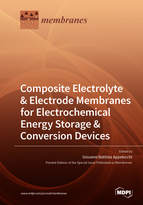Composite Electrolyte & Electrode Membranes for Electrochemical Energy Storage & Conversion Devices
A special issue of Membranes (ISSN 2077-0375). This special issue belongs to the section "Membrane Applications".
Deadline for manuscript submissions: closed (31 January 2020) | Viewed by 49950
Special Issue Editor
Interests: research and development of electrolyte/electrode materials/components for electrochemical energy storage systems; ionic liquids; polymer and gel electrolytes; lithium batteries
Special Issues, Collections and Topics in MDPI journals
Special Issue Information
Dear Colleagues,
Energy demand is still mainly satisfied by the direct but inefficient and polluting conversion of chemical energy of fossil fuels because of the lack of highly performing energy storage systems. Electrochemical power sources differ from others due to the fact that the energy conversion occurs from chemical into electrical without any intermediate step, resulting in higher energy efficiencies in addition to a much lower environmental impact due to the absence of any gaseous emission. Among the various choices, electrochemical devices, such as batteries, supercapacitors, and fuel cells, are one of the most, if not the most, suitable answers for efficient energy storage and conversion.
Electrode chemistry and formulation play a key role in the performance and safety of electrochemical devices. For instance, electrodes, in addition to electrochemical active species, have to contain passive components (electronic and/or ionic conductor, binder, etc.), which, even if not affecting the energy density, strongly influence the power density, cycling behavior, and reliability of the device. Therefore, although well-known over time, these issues are currently under deep investigation worldwide.
This Special Issue will offer an appealing forum to bring together the latest results obtained by key laboratories presently involved in R and D of composite electrodes for batteries, supercapacitors, and fuel cells. Again, this Special Issue represents an optimal site for welcoming the latest innovations and, accordingly, authors from top laboratories are invited to submit their forthcoming results.
Dr. Giovanni Battista Appetecchi
Guest Editor
Manuscript Submission Information
Manuscripts should be submitted online at www.mdpi.com by registering and logging in to this website. Once you are registered, click here to go to the submission form. Manuscripts can be submitted until the deadline. All submissions that pass pre-check are peer-reviewed. Accepted papers will be published continuously in the journal (as soon as accepted) and will be listed together on the special issue website. Research articles, review articles as well as short communications are invited. For planned papers, a title and short abstract (about 100 words) can be sent to the Editorial Office for announcement on this website.
Submitted manuscripts should not have been published previously, nor be under consideration for publication elsewhere (except conference proceedings papers). All manuscripts are thoroughly refereed through a single-blind peer-review process. A guide for authors and other relevant information for submission of manuscripts is available on the Instructions for Authors page. Membranes is an international peer-reviewed open access monthly journal published by MDPI.
Please visit the Instructions for Authors page before submitting a manuscript. The Article Processing Charge (APC) for publication in this open access journal is 2700 CHF (Swiss Francs). Submitted papers should be well formatted and use good English. Authors may use MDPI's English editing service prior to publication or during author revisions.
Keywords
- batteries
- supercapacitors
- fuel cells
- composite electrodes
- electrode formulation







